Seismic Soil–Structure Interaction of Three Historical Buildings at the University of Catania (Sicily, Italy)
Abstract
1. Introduction
2. Seismological and Geological Framework
2.1. Historical Seismicity
2.2. Geological Setting
3. Description of Investigated Buildings
3.1. Villa Cerami
3.2. Palazzo Boscarino
3.3. Villa Zingali Tetto
4. Methods
5. Data Acquisition and Results
5.1. Ambient Vibration Samplings
5.2. Building Damping
5.3. Torsional Effects
5.4. One-Dimensional Site Response Modelling
6. Discussion
7. Conclusions
Author Contributions
Funding
Data Availability Statement
Acknowledgments
Conflicts of Interest
References
- Bard, P.Y.; Bouchon, M. The two-dimensional resonance of sediment-filled valleys. Bull. Seism. Soc. Am. 1985, 75, 519–541. [Google Scholar] [CrossRef]
- Faccioli, E. Seismic amplification in the presence of geological and topographic irregularities. In Proceedings of the 2nd International Conference on Recent Advances in Geotechnical Earthquake Engineering and Soil Dynamics, St. Louis, MO, USA, 11–15 March 1991; pp. 1779–1797. [Google Scholar]
- Naganoh, M.; Kagami, H.; Muratami, H. Effects of surface and subsurface irregularities. In Earthquake Motions and Ground Conditions; The Architectural Institute: Tokyo, Japan, 1993; Section 3.3. [Google Scholar]
- Steidl, J.H.; Tumarkin, A.G.; Archuleta, R. What is a reference site? Bull. Seism. Soc. Am. 1996, 86, 1733–1748. [Google Scholar] [CrossRef]
- Borcherdt, R.D. Effects of local geology on ground motion near San Francisco Bay. Bull. Seism. Soc. Am. 1970, 60, 29–61. [Google Scholar] [CrossRef]
- Nakamura, Y. A Method for Dynamic Characteristics Estimation of Sub Surface Using Microtremor on the Ground Surface. Railw. Tech. Res. Inst. Q. Rep. 1989, 30, 25–33. [Google Scholar]
- Trifunac, M.D. Comparison between ambient and forced vibration experiments. Earthq. Eng. Struct. Dyn. 1972, 1, 133–150. [Google Scholar] [CrossRef]
- Lermo, J.; Chavez-Garcia, F.J. Site effect evaluation using spectral ratios with only one station. Bull. Seism. Soc. Am. 1993, 83, 1574–1594. [Google Scholar] [CrossRef]
- Seekins, L.C.; Wennerberg, L.; Marghereti, L.; Liu, H.P. Site amplification at five locations in San Francisco, California: A comparison of S waves, codas, and microtremors. Bull. Seism. Soc. Am. 1996, 86, 627–635. [Google Scholar] [CrossRef]
- Haghshenas, E.; Bard, P.Y.; Theodulidis, N. SESAME WP04 Team. Empirical evaluation of microtremor H/V spectral ratio. Bull. Earthq. Eng. 2008, 6, 75–108. [Google Scholar] [CrossRef]
- Moisidi, M.; Vallianatos, F.; Gallipoli, M.R. Assessing the Main Frequencies of Modern and Historical Buildings Using Ambient Noise Recordings: Case Studies in the Historical Cities of Crete (Greece). Heritage 2018, 1, 171–188. [Google Scholar] [CrossRef]
- Burjànek, J.; Moore, J.R.; Molina, F.X.Y.; Fäh, D. Instrumental evidence of normal mode rock slope vibration. Geophys. J. Int. 2012, 188, 559–569. [Google Scholar] [CrossRef]
- Imposa, S.; Lombardo, G.; Panzera, F.; Grassi, S. Ambient Vibrations Measurements and 1D Site Response Modelling as a Tool for Soil and Building Properties Investigation. Geosciences 2018, 8, 87. [Google Scholar] [CrossRef]
- Albarello, D.; Lunedei, E. Combining horizontal ambient vibration components for H/V spectral ratio estimates. Geophys. J. Int. 2013, 194, 936–951. [Google Scholar] [CrossRef]
- Pappalardo, G.; Imposa, S.; Barbano, M.S.; Grassi, S.; Mineo, S. Study of landslides at the archaeological site of Abakainon necropolis (NE Sicily) by geomorphological and geophysical investigations. Landslides 2018, 15, 1279–1297. [Google Scholar] [CrossRef]
- Gentile, C.; Saisi, A.; Cabboi, A. Structural Identification of a Masonry Tower Based on Operational Modal Analysis. Int. J. Archit. Herit. 2015, 9, 98–110. [Google Scholar] [CrossRef]
- D’Altri, A.M.; de Miranda, S.; Castellazzi, G.; Sarhosis, V. A 3D detailed micro-model for the in-plane and out-of-plane numerical analysis of masonry panels. Comput. Struct. 2018, 206, 18–30. [Google Scholar] [CrossRef]
- D’Altri, A.M.; Sarhosis, V.; Milani, G.; Rots, J.; Cattari, S.; Lagomarsino, S.; Sacco, E.; Tralli, A.; Castellazzi, G.; Miranda, S. Modeling Strategies for the Computational Analysis of Unreinforced Masonry Structures: Review and Classification. Arch. Comput. Methods Eng. 2020, 27, 1153–1185. [Google Scholar] [CrossRef]
- Castellaro, S.; Imposa, S.; Barone, F.; Chiavetta, F.; Gresta, S.; Mulargia, F. Georadar and Passive Seismic Survey in the Roman Amphitheatre of Catania (Sicily). J. Cult. Herit. 2008, 9, 357–366. [Google Scholar] [CrossRef]
- Beskhyroun, S.; Navabian, N.; Wotherspoon, L.; Ma, Q. Dynamic behaviour of a 13-story reinforced concrete building under ambient vibration, forced vibration, and earthquake excitation. J. Build. Eng. 2020, 28, 101066. [Google Scholar] [CrossRef]
- Grassi, S.; Imposa, S.; Patti, G.; Boso, D.; Lombardo, G.; Panzera, F. Geophysical surveys for the dynamic characterization of a cultural heritage building and its subsoil: The S. Michele Arcangelo Church (Acireale, eastern Sicily). J. Cult. Herit. 2019, 36, 72–84. [Google Scholar] [CrossRef]
- Grassi, S.; Patti, G.; Tiralongo, P.; Imposa, S.; Aprile, D. Applied geophysics to support the cultural heritage safeguard: A quick and non-invasive method to evaluate the dynamic response of a great historical interest building. J. Appl. Geophy. 2021, 189, 104321. [Google Scholar] [CrossRef]
- Rovida, A.; Locati, M.; Camassi, R.; Lolli, B.; Gasperini, P. The Italian earthquake catalogue CPTI15. Bull. Earthq. Eng. 2020, 18, 2953–2984. [Google Scholar] [CrossRef]
- Lanzano, G.; Luzi, L.; D’Amico, V.; Pacor, F.; Meletti, C.; Marzocchi, W.; Rotondi, R.; Varini, E. Ground motion models for the new seismic hazard model of Italy (MPS19): Selection for active shallow crustal regions and subduction zones. Bull. Earthq. Eng. 2020, 18, 3487–3516. [Google Scholar] [CrossRef]
- Barbano, M.S.; Castelli, V.; Pantosti, D.; Pirrotta, C. Integration of historical, archaeoseismic and paleoseismological data for the reconstruction of the early seismic history in Messina Strait (south Italy): The 1st and 4th centuries AD earthquakes. Ann. Geophys. 2014, 57, S0192. [Google Scholar] [CrossRef]
- Guidoboni, E.; Ferrari, G.; Mariotti, D.; Comastri, A.; Tarabusi, G.; Sgattoni, G.; Valensise, G. CFTI5Med, Catalogo dei Forti Terremoti in Italia (461 a.C.-1997) e Nell’area Mediterranea (760 a.C.-1500). Istituto Nazionale di Geofisica e Vulcanologia; INGV: Bologna, Italy, 2018. [Google Scholar] [CrossRef]
- Pirrotta, C.; Barbano, M.S. New Macroseismic and Morphotectonic Constraints to Infer a Fault Model for the 9 (Mw6.1) and 11 January (Mw7.3) 1693 Earthquakes (Southeastern Sicily). Front. Earth. Sci. 2020, 8, 550851. [Google Scholar] [CrossRef]
- Amato, A.; Azzara, R.; Basili, A.; Chiarabba, C.; Cocco, M.; Di Bona, M.; Selvaggi, G. Main shock and aftershocks of the December 13, 1990, Eastern Sicily earthquake. Ann. Geophys. 1995, 38, 255–266. [Google Scholar] [CrossRef]
- Monaco, C.; Catalano, S.; De Guidi, G.; Gresta, S.; Langer, H.; Tortorici, L. The geological map of the urban area of Catania (Eastern Sicily): Morphotectonic and seismotectonic implications. Mem. Soc. Geol. Ital. 2000, 55, 425–438. [Google Scholar]
- Azzaro, R.; Barbano, M.S.; Moroni, A.; Mucciarelli, M.; Stucchi, M. The seismic history of Catania. J. Seismol. 1999, 3, 235–252. [Google Scholar] [CrossRef]
- Scudero, S.; De Guidi, G.; Imposa, S.; Currenti, G. Modelling the long-term deformation of the sedimentary substrate of Mt. Etna volcano (Italy). Terra Nova 2015, 27, 338–345. [Google Scholar] [CrossRef]
- Lombardo, G.; Coco, G.; Corrao, M.; Imposa, S.; Azzara, R.; Cara, F.; Rovelli, A. Results of microtremor measurements in the urban area of Catania (Italy). Boll. Geofis. Teor. Appl. 2001, 42, 317–334. [Google Scholar]
- UniCT Seismic Microzonation Working Group. Microzonazione Sismica (MS) di Livello 1. D.D.G. n. 219 del 08/07/2014. 2014. Available online: http://sit.protezionecivilesicilia.it/ (accessed on 23 September 2021).
- NTC. Aggiornamento Delle «Norme Tecniche per le Costruzioni». Ministero delle Infrastrutture e dei Trasporti: Rome, Italy, 2018; Gazzetta Ufficiale della Repubblica Italiana: Rome, Italy, 2018. [Google Scholar]
- La Sicilia, 1990.12.21, a.46, n.349. Catania (Italy). ANSA, Notiziario Italiano, 21 December 1990.
- Eurocode 8. Design of Structures for Earthquake Resistance—Part 1: General Rules, Seismic Actions and Rules for Buildings; EN 1998-1; European Committee for Standardization (CEN): Brussels, Belgium, 2004; Available online: www.eurocodes.jrc.eceuropa.eu/ (accessed on 23 September 2021).
- Ditommaso, R.; Parolai, S.; Mucciarelli, M.; Eggert, S.; Sobiesiak, M.; Zschau, J. Monitoring the response and the back-radiated energy of a building subjected to ambient vibration and impulsive action: The Falkenhof Tower (Potsdam, Germany). Bull. Earthq. Eng. 2010, 8, 705–722. [Google Scholar] [CrossRef]
- Michel, C.; Guéguen, P. Time–frequency analysis of small frequency variations in civil engineering structures under weak and strong motions using a reassignment method. Struct. Health. Monit. 2010, 9, 159–171. [Google Scholar] [CrossRef]
- Todorovska, M.I. Soil-structure system identification of Millikan library north–south response during four earthquakes (1970–2002): What caused the observed wandering of the system frequencies? Bull. Seism. Soc. Am. 2009, 99, 626–635. [Google Scholar] [CrossRef]
- Gallipoli, M.R.; Mucciarelli, M.; Vona, M. Empirical estimate of fundamental frequencies and damping for Italian buildings. Earthq. Eng. Struct. Dyn. 2009, 38, 973–988. [Google Scholar] [CrossRef]
- Celebi, M. Comparison of damping in buildings under low-amplitude and strong motions. J. Wind. Eng. Ind. Aerodyn. 1996, 59, 309–323. [Google Scholar] [CrossRef]
- Trifunac, M.D.; Todorovska, M.I.; Manić, M.I.; Bulajić, B.Đ. Variability of the fixed-base and soil-structure system frequencies of a building—The case of Borik-2 building. Struct. Control Health Monit. 2010, 17, 120–151. [Google Scholar] [CrossRef]
- Hoult, R. A computationally-effective method for rapidly determining the seismic structural response of high-rise buildings with a limited number of sensors. Bull. Earthq. Eng. 2021, 20, 4395–4417. [Google Scholar] [CrossRef]
- Mucciarelli, M.; Gallipoli, M.R.; Ponzo, C.F.; Dolce, M. Seismic waves generated by oscillating building. Soil Dyn. Earthq. Eng. 2003, 23, 255–262. [Google Scholar] [CrossRef]
- Cornou, C.; Guéguen, P.; Bard, P.Y.; Haghshenas, E. Ambient noise energy bursts observation and modeling: Trapping of harmonic structure-soil induced–waves in a topmost sedimentary layer. J. Seismol. 2004, 8, 507–524. [Google Scholar] [CrossRef][Green Version]
- Bulajić, B.Đ.; Todorovska, M.T.; Manić, M.I.; Trifunac, M.D. Structural health monitoring study of the ZOIL building using earthquake records. Soil Dyn. Earthq. Eng. 2020, 133, 106105. [Google Scholar] [CrossRef]
- Kottke, A.R.; Rathje, E.M. Technical Manual for Strata; PEER Report 2008/10; University of California: Berkeley, CA, USA, 2008; Available online: http://nees.org/resources/strata (accessed on 15 February 2022).
- Rathje, E.M.; Kottke, A. Strata. 2013. Available online: https://nees.org/resources/strata (accessed on 15 February 2022).
- Grünthal, G. European Macroseismic Scale 1998 (EMS-98). In European Seismological Commission, Subcommission on Engineering Seismology, Working Group Macroseismic Scales. Cahiers du Centre Européen de Géodynamique et de Séismologie, Conseil de l’Europe Luxembourg; European Seismological Commission: Geneva, Switzerland, 1998; Volume 15, 99p. [Google Scholar]
- Picozzi, M.; Strollo, A.; Parolai, S.; Durukal, E.; Özel, O.; Karabulut, S.; Zschau, J.; Erdik, M. Site characterization by seismic noise in Istanbul, Turkey. Soil Dyn. Earthq. Eng. 2009, 29, 69–482. [Google Scholar] [CrossRef]
- Konno, K.; Ohmachi, T. Ground-motion characteristics estimated from spectral ratio between horizontal and vertical components of microtremor. Bull. Seism. Soc. Am. 1998, 88, 228–241. [Google Scholar] [CrossRef]
- Snieder, R.; Safak, E. Extracting the building response using seismic interferometry: Theory and application to the Millikan Library in Pasadena, California. Bull. Seism. Soc. Am. 2006, 96, 586–598. [Google Scholar] [CrossRef]
- Castellaro, S.; Mulargia, F. How far from a building does the ground motion free field start? The cases of three famous towers and of a modern building. Bull. Seism. Soc. Am. 2010, 100, 2080–2094. [Google Scholar] [CrossRef]
- SESAME. Guidelines for the Implementation of the H/V Spectral Ratio Technique on Ambient Vibrations Measurements, Processing and Interpretation. 2004. Available online: http://sesamegeopsy.org/Papers/HV_User_Guidelines.pdf (accessed on 11 December 2021).
- Dunand, F.; Bard, P.Y.; Chatelain, J.L.; Gueguen, P.; Vassail, T.; Farsi, M.N. Damping and frequency from randomec method applied to in-situ measurements of ambient vibrations: Evidence for effective soil structure interaction. In Proceedings of the 12th European Conference on Earthquake Engineering, London, UK, 9–13 September 2002; Paper No. 868; Elsevier Science Ltd.: Amsterdam, The Netherlands, 2002. [Google Scholar]
- Wathelet, M.; Chatelain, J.L.; Cornou, C.; Di Giulio, G.; Guillier, B.; Ohrnberger, M.; Savvaidis, A. Geopsy: A User-Friendly Open-Source Tool Set for Ambient Vibration Processing. Seismol. Res. Lett. 2020, 91, 1878–1889. Available online: http://www.geopsy.org/ (accessed on 20 December 2021). [CrossRef]
- Kareem, A.; Gurley, K. Damping in structures: Its evaluation and treatment of uncertainty. J. Wind. Eng. Ind. Aerodyn. 1996, 59, 131–157. [Google Scholar] [CrossRef]
- Grimaz, S.; Barazza, F.; Malisan, P. Misure all’interno degli edifici. In A Cura di M. Mucciarelli, Tecniche Speditive per la Stima Dell’amplificazione Sismica e Della Dinamica Degli Edifici-Studi Teorici ed Applicazioni Professionali; Aracne: Rome, Italy, 2011; pp. 195–209. ISBN 978-88-548-4495-7. [Google Scholar] [CrossRef]
- Mucciarelli, M. Reliability and applicability of Nakamura’s technique using microtremors: An experimental approach. J. Earthq. Eng. 1998, 2, 625–638. [Google Scholar] [CrossRef]
- Assimaki, D.; Kausel, E. An Equivalent Linear Algorithm with Frequency-and-Pressure-Dependent Moduli and Damping for Seismic Analysis of Deep Sites. Soil Dyn. Earthq. Eng. 2002, 22, 959–965. [Google Scholar] [CrossRef]
- Seed, H.B.; Idriss, I.M. Soil Moduli and Damping Factors for Dynamic Response Analyses; Report No. EERC-70-10; University of California: Berkeley, CA, USA, 1970. [Google Scholar]
- Faccioli, E.; Pessina, V. The Catania Project: Earthquake Damage Scenarios for High Risk Area in the Mediterranean; CNR—Gruppo Nazionale per la Difesa Terremoti: Rome, Italy, 2000; 225p. [Google Scholar]
- Carrubba, P.; Maugeri, M. Determinazione delle proprietà dinamiche di un’argilla mediante prove di colonna risonante. Riv. Ital. Geotecnica 1988, 22, 101–113. (In Italian) [Google Scholar]
- Cavallaro, A.; Grasso, S.; Maugeri, M. A dynamic geothechnical characterization of soil at Saint Nicola alla Rena Church damaged by South Eastern Sicily Earthquake of 13 December 1990. In Proceedings of the 15th International Conference on Soil Mechanics and Geotechnical Engineering, Satellite Conference Lessons Learned from Recent Strong Earthquake, Istanbul, Turkey, 25 August 2001; pp. 243–248. [Google Scholar]
- Cauzzi, C.; Faccioli, E.; Vanini, M.; Bianchini, A. Updated predictive equations for broadband (0.01–10 s) horizontal response spectra and peak ground motions, based on a global dataset of digital acceleration records. Bull. Earthq. Eng. 2015, 13, 1587–1612. [Google Scholar] [CrossRef]
- Visini, F.; De Nardis, R.; Barbano, M.S.; Lavecchia, G. Testing the seismogenic sources of the January 11th 1693 Sicilian earthquake (Io X/XI): Insights from macroseismic field simulations. Ital. J. Geosci. 2009, 128, 147–156. [Google Scholar]
- Luzi, L.; Lanzano, G.; Felicetta, C.; D’Amico, M.C.; Russo, E.; Sgobba, S.; Pacor, F. ; ORFEUS Working Group 5. Engineering Strong Motion Database (ESM) (Version 2.0); Istituto Nazionale di Geofisica e Vulcanologia (INGV): Rome, Italy, 2020. [Google Scholar] [CrossRef]
- Sgobba, S.; Puglia, R.; Pacor, F.; Luzi, L.; Russo, E.; Felicetta, C.; Lanzano, G.; D’Amico, M.; Baraschino, R.; Baltzopoulos, G.; et al. REXEL web: A tool for selection of ground-motion records from the Engineering Strong Motion database (ESM). In Proceedings of the 7th International Conference on Earthquake Geotechnical Engineering (ICEGE), Roma, Italy, 17–20 June 2019; 2019. [Google Scholar]
- Lagomarsino, S. Forecast models for damping and vibration periods of buildings. J. Wind Eng. Ind. Aerodyn. 1993, 48, 221–239. [Google Scholar] [CrossRef]
- Salameh, C.; Guillier, B.; Harb, J.; Cornou, C.; Bard, P.Y.; Voisin, C.; Mariscal, A. Seismic response of Beirut (Lebanon) buildings: Instrumental results from ambient vibrations. Bull. Earthq. Eng. 2016, 14, 2705–2730. [Google Scholar] [CrossRef]
- Ha, T.; Shin, S.H.; Kim, H. Damping and natural period evaluation of tall RC buildings using full-scale data in Korea. Appl. Sci. 2020, 10, 1568. [Google Scholar] [CrossRef]
- Locati, M.; Gomez Capera, A.; Puglia, R.; Santulin, M. Rosetta, a tool for linking accelerometric recordings and macroseismic observations: Description and applications. Bull. Earthq. Eng. 2017, 15, 2429–2443. [Google Scholar] [CrossRef]
- Faenza, L.; Michelini, A. Regression analysis of MCS intensity and ground motion spectral accelerations (SAs) in Italy. Geophys. J. Int. 2011, 186, 1415–1430. [Google Scholar] [CrossRef]
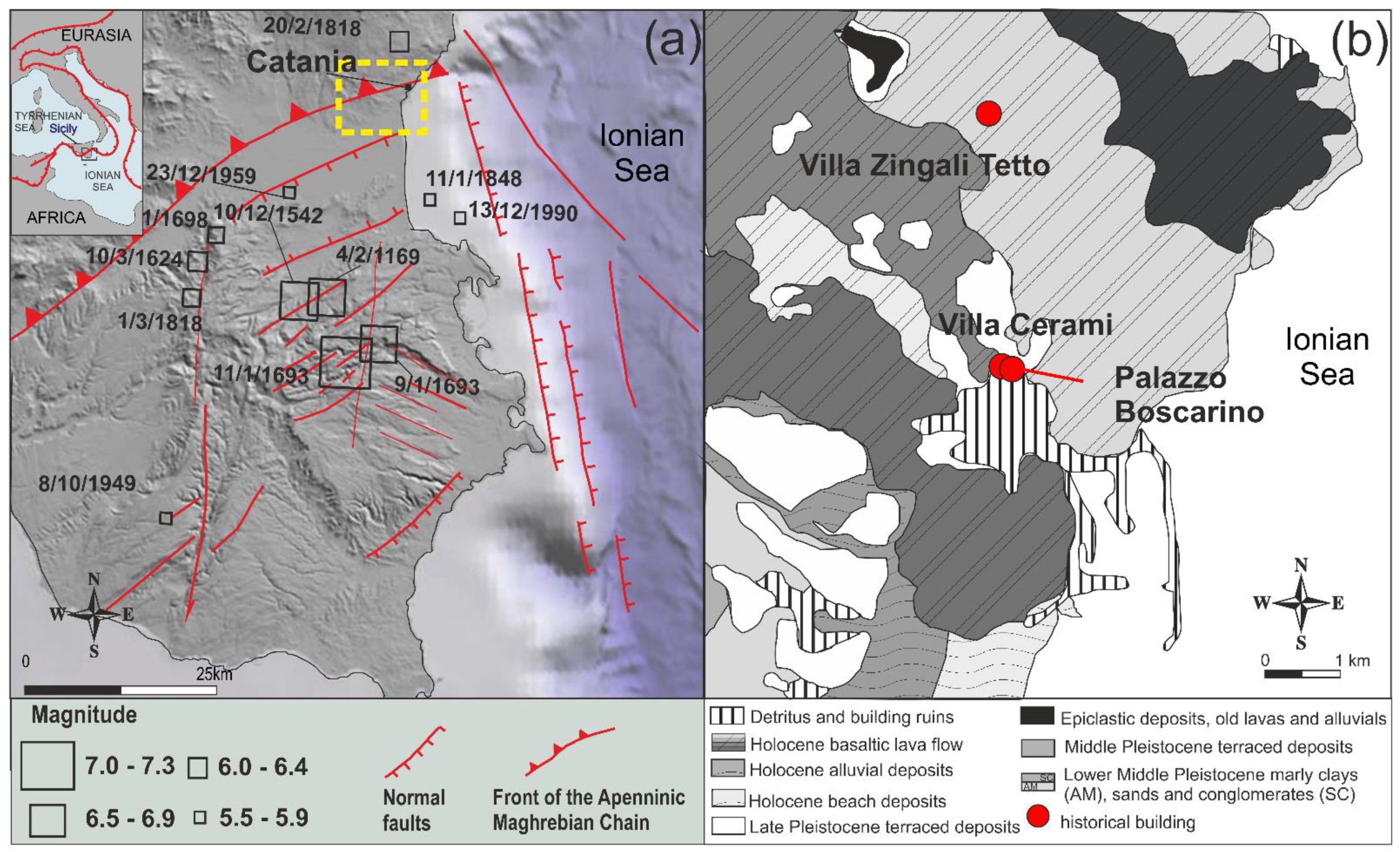
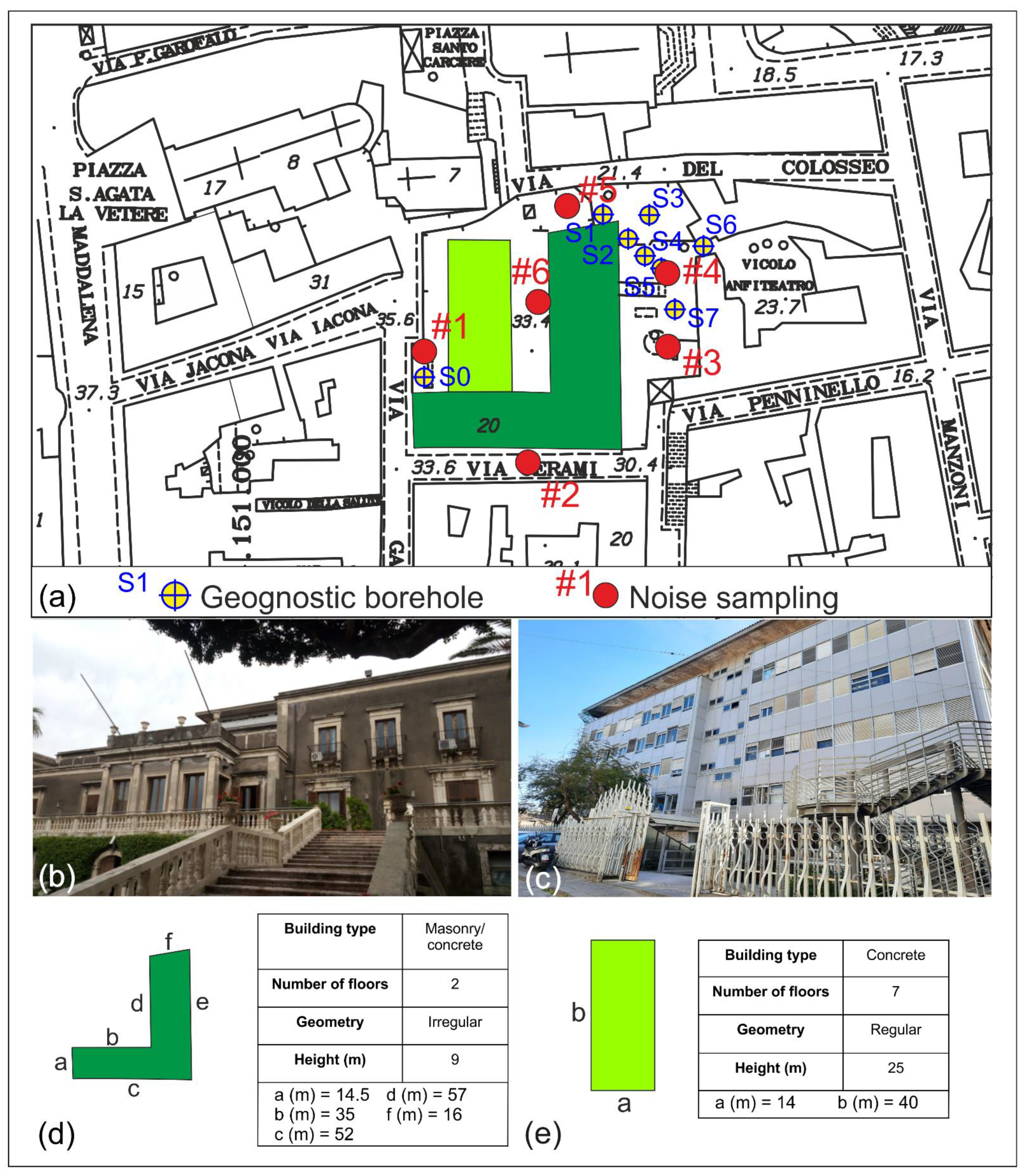
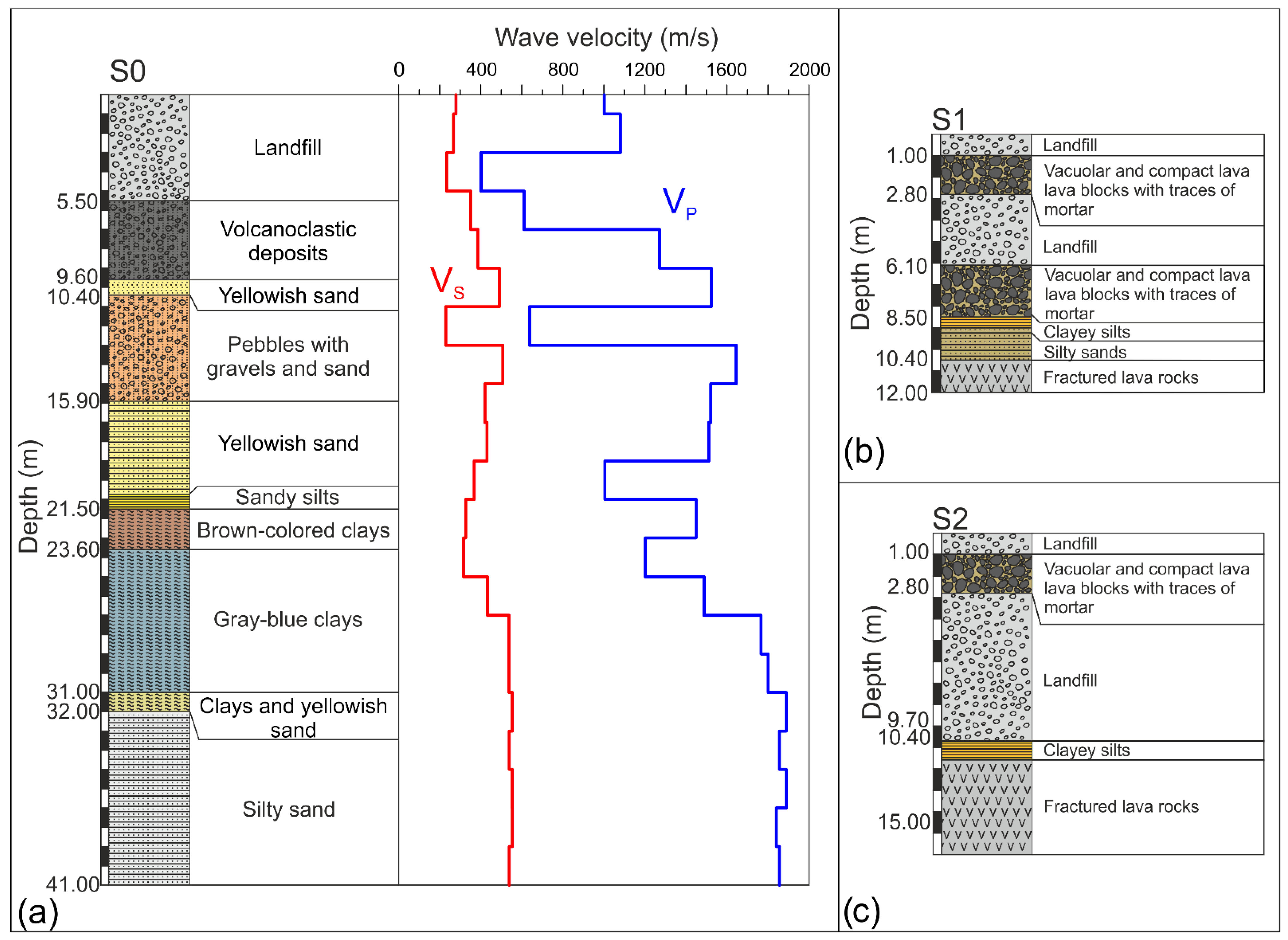

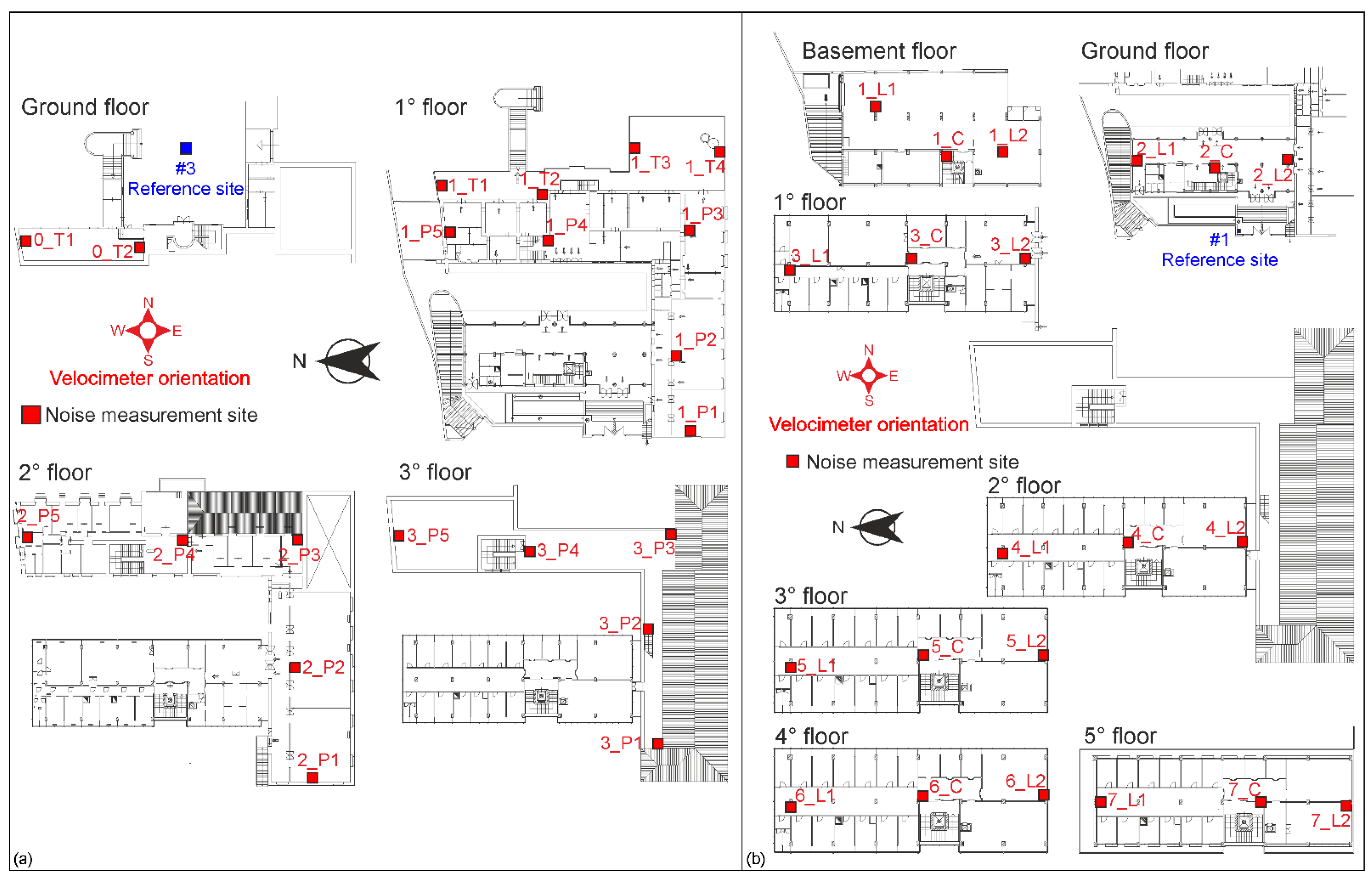
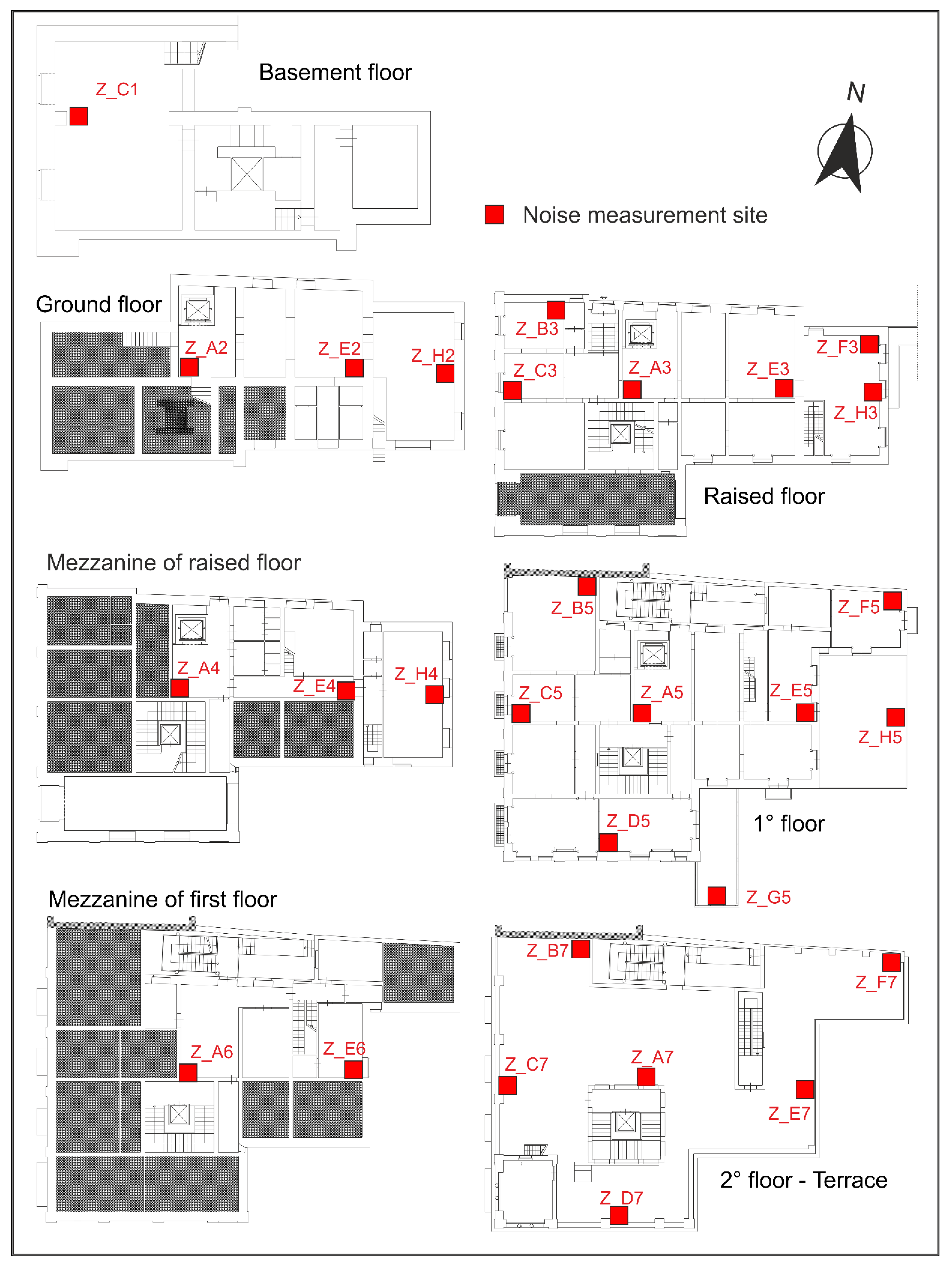
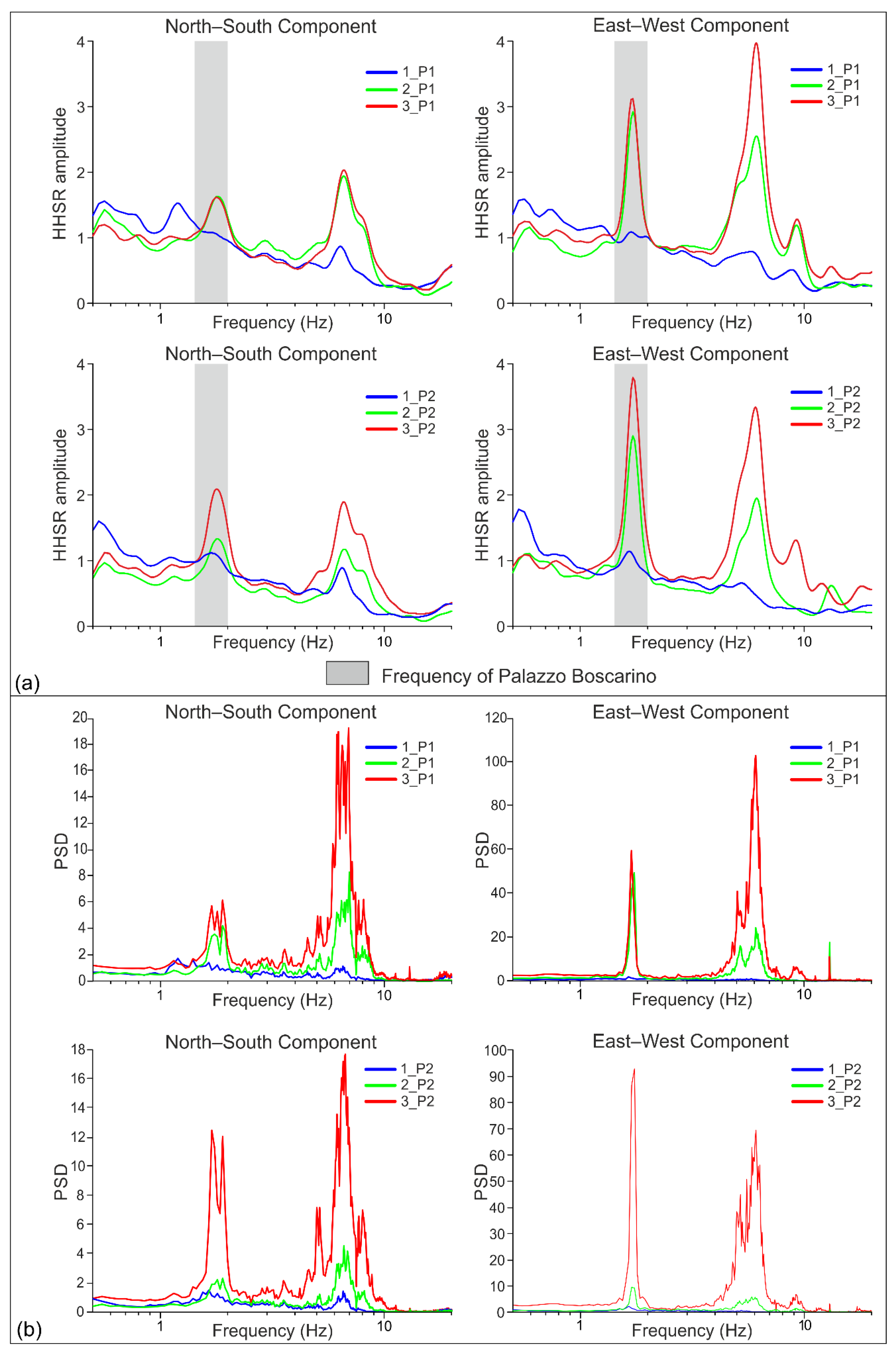
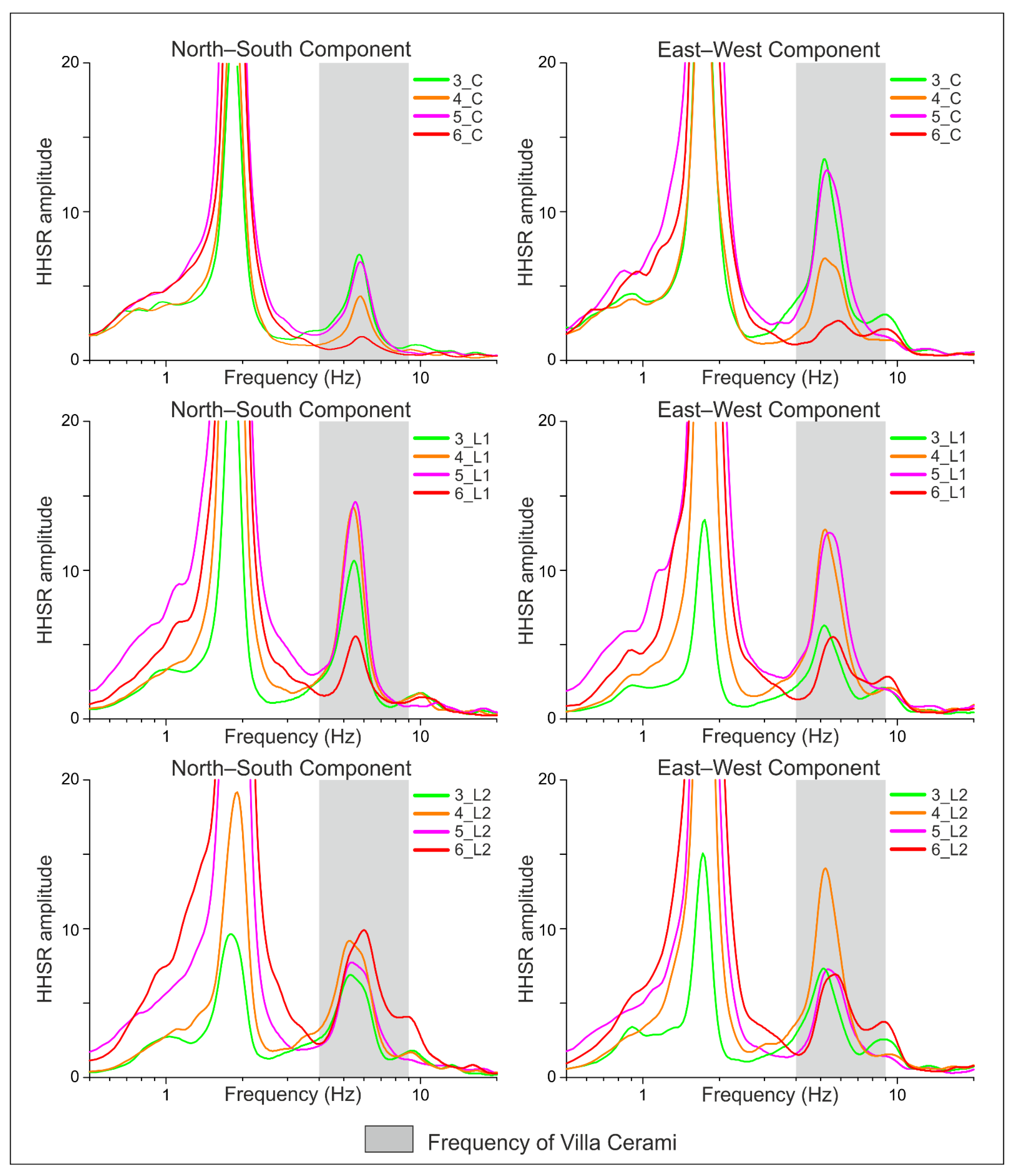
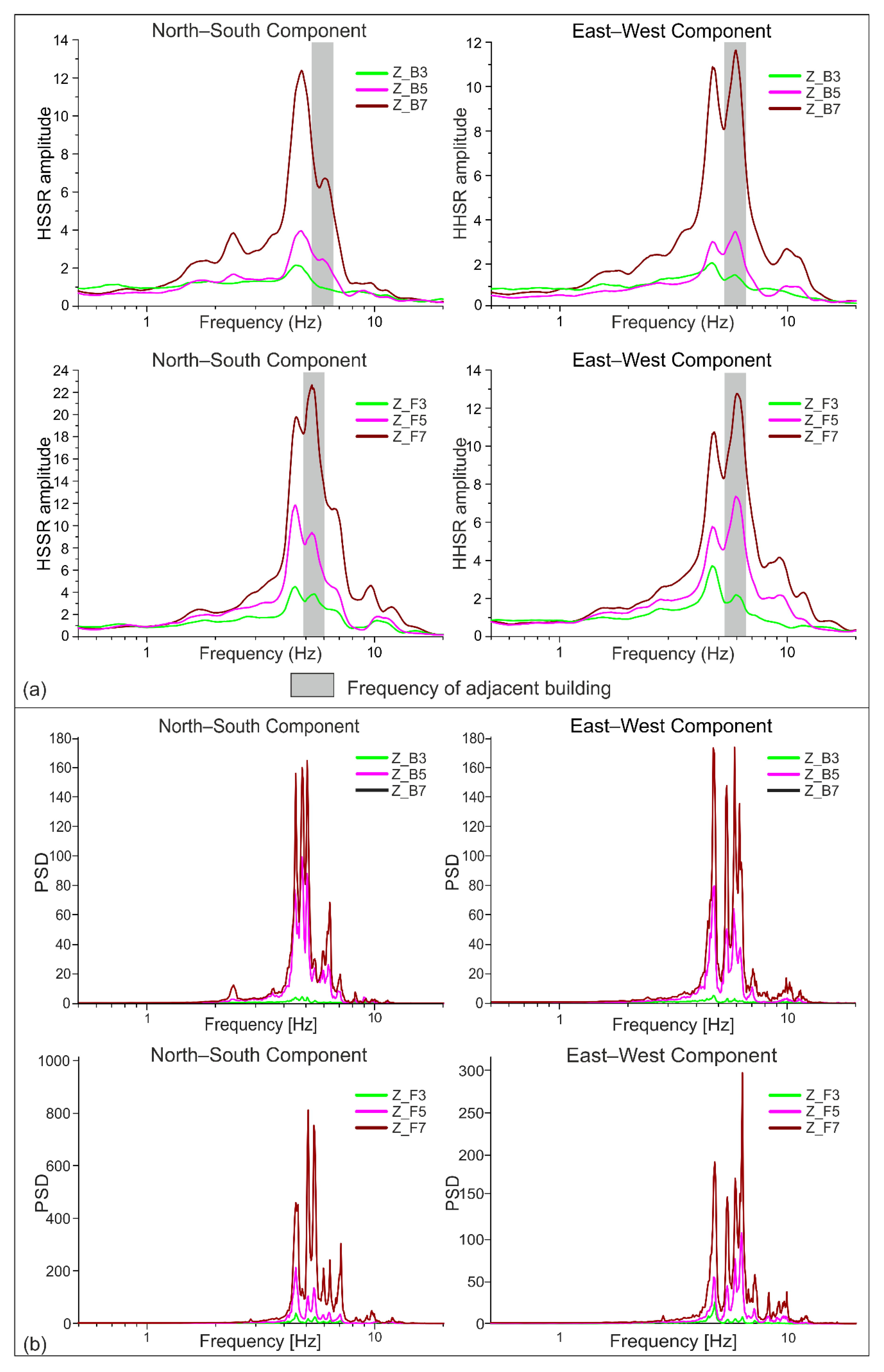
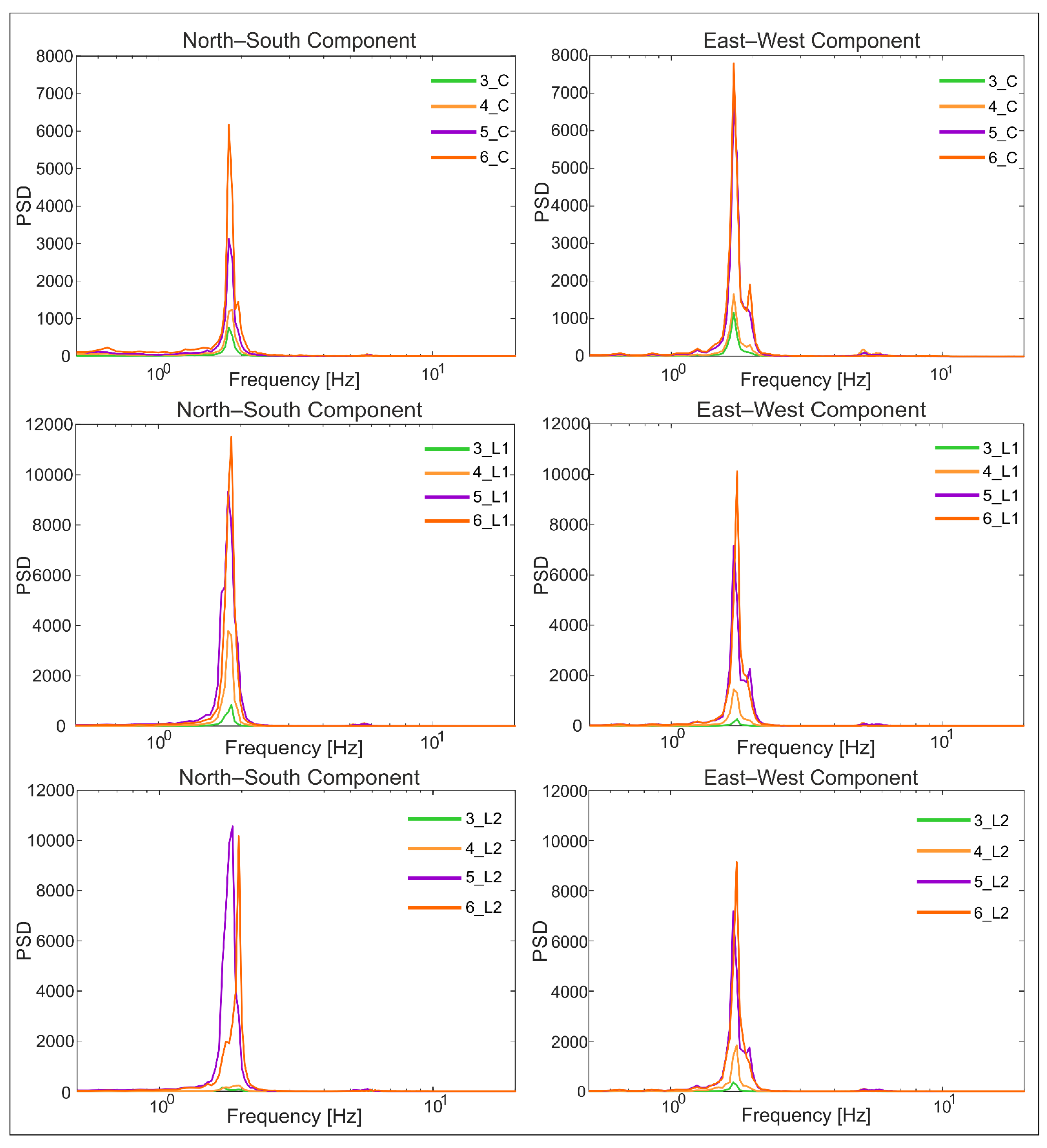
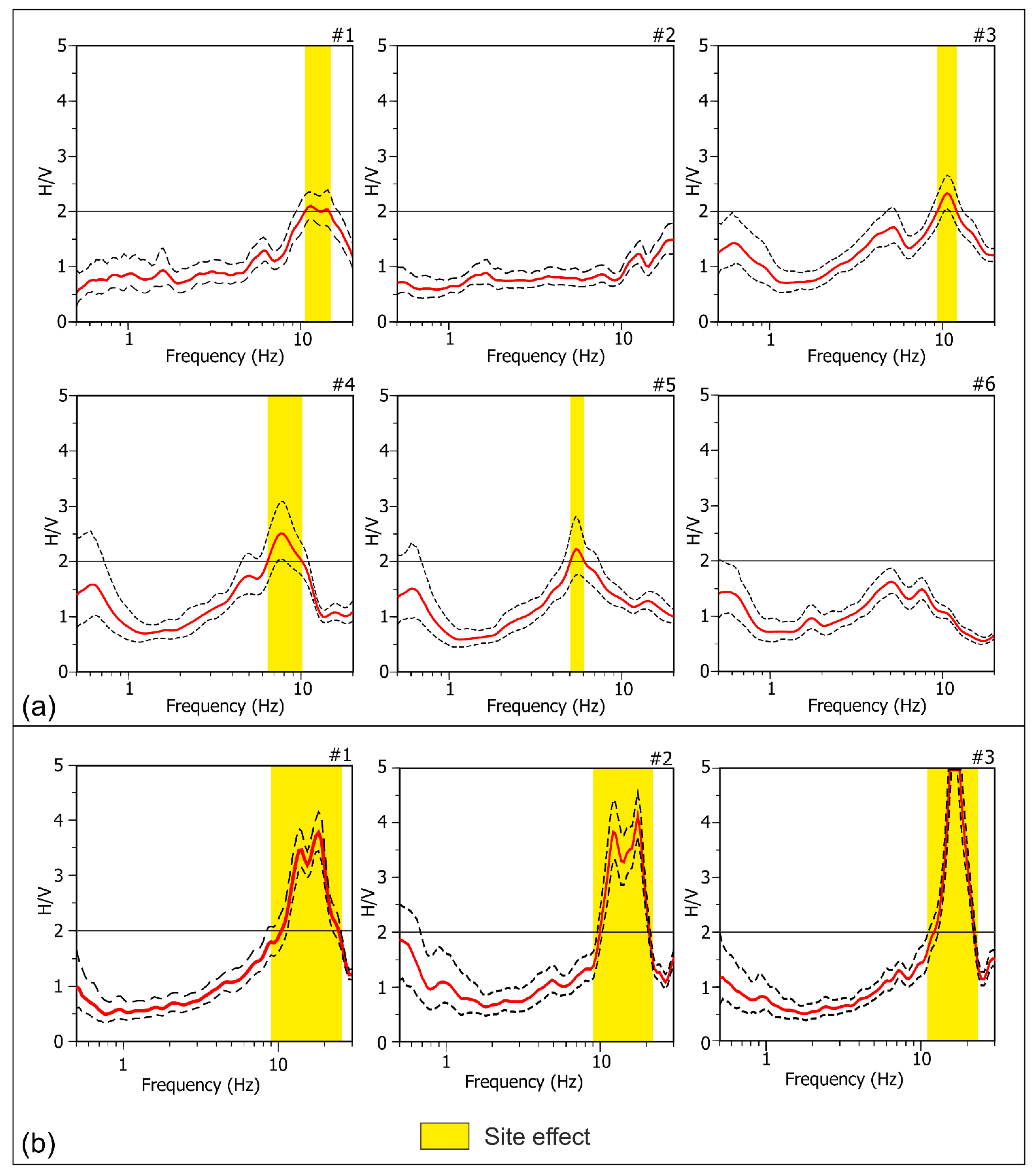


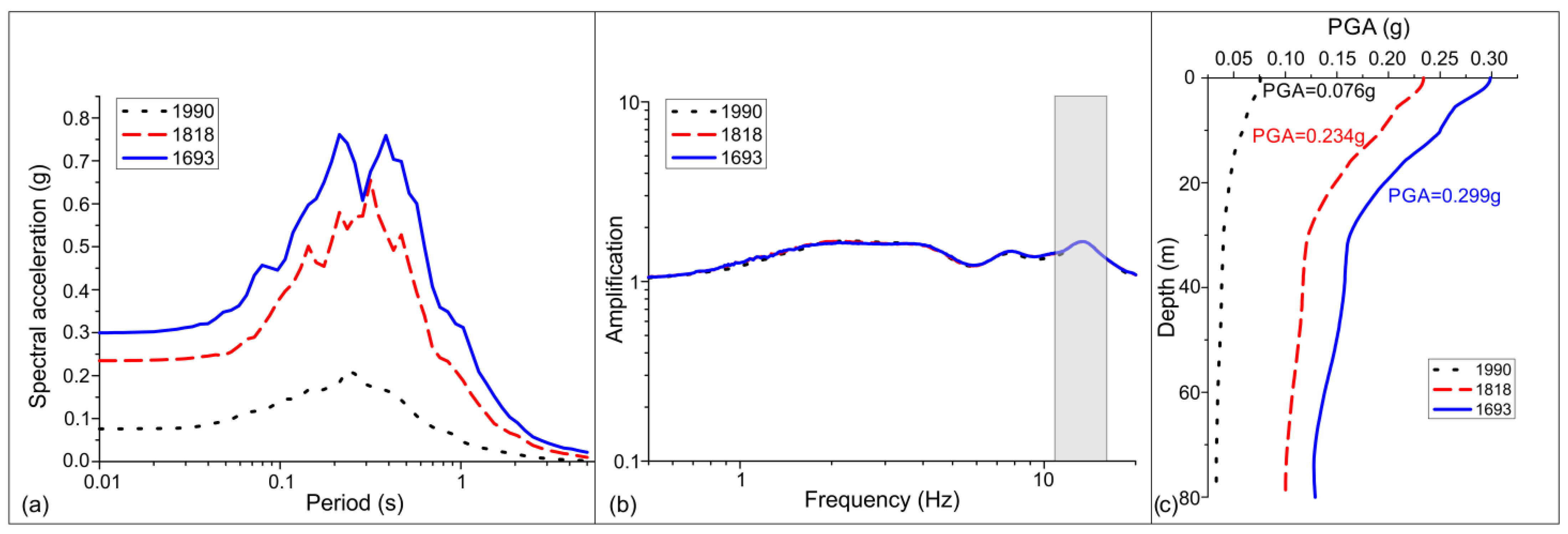
| Year | Mo | Day | Ho Mi | Epicentral Area | I0 | Mw | Iobs (MCS) |
|---|---|---|---|---|---|---|---|
| 1693 | 01 | 09 | 21 00 | Southeastern Sicily | 8–9 | 6.07 | 8 |
| 1693 | 01 | 11 | 13 30 | Southeastern Sicily | 11 | 7.32 | 10–11 |
| 1818 | 02 | 20 | 18 15 | Catania area | 9–10 | 6.28 | 7 |
| 1846 | 04 | 22 | 19 45 | Catania plain | 6 | 4.94 | 6 |
| 1848 | 01 | 11 | 12 00 | Gulf of Catania | 7–8 | 5.51 | 6 |
| 1908 | 12 | 28 | 04 20 | Strait of Messina | 11 | 7.10 | 6–7 |
| 1959 | 12 | 23 | 22 52 | Catania plain | 6–7 | 5.11 | 6 |
| 1990 | 12 | 13 | 00 24 | Southeastern Sicily | 5.61 | 6 |
| Frequency (Hz) | Central Displacement | Lateral Displacement | Component | Δ | ||
|---|---|---|---|---|---|---|
| Villa Cerami | 3_P5 | 5.95 | ----- | 0.000052 | N–S | 3.5 |
| 3_P4 | 6.67 | 0.000015 | ----- | N–S | ||
| Palazzo Boscarino | 7_L1 | 1.91 | ----- | 0.0026 | N–S | 2.2 |
| 7_C | 1.88 | 0.0012 | ----- | N–S | ||
| 7_L2 | 1.91 | ----- | 0.0018 | N–S | 1.5 | |
| 7_C | 1.88 | 0.0012 | ----- | N–S | ||
| Villa Zingali Tetto | Z_D7 | 4.8 | ----- | 0.0000419 | E–W | 1.5 |
| Z_A7 | 4.8 | 0.0000275 | ----- | E–W | ||
| Z_C7 | 4.8 | ----- | 0.0000475 | N–S | 2.6 | |
| Z_A7 | 4.3 | 0.0000182 | ----- | N–S | ||
| Z_F7 | 4.5 | ----- | 0.0000560 | N–S | 3.0 | |
| First Level Scenario (Mw 7.3) | |||||||
|---|---|---|---|---|---|---|---|
| Earthquake Name | Station Code | Date | Mw | Fault Mechanism | Epicentral Distance (km) | Eurocode 8 Site Class | |
| A | Friuli _3rd shock (Italy) | SRC0 | 1976-09-15 | 6 | Thrust | 15.8 | A |
| B | Irpinia (Italy) | BSC (E) | 1980-11-23 | 6.9 | Normal | 28.3 | A |
| C | Duzce (Turkey) | D0531 | 1999-11-12 | 7.3 | Strike-slip | 30.3 | A |
| D | Central Italy | T1212 | 2016-10-30 | 6.5 | Normal | 10.5 | A |
| E | Irpinia (Italy) | BSC (N) | 1980-11-23 | 6.9 | Normal | 28.3 | A |
| F | Central Italy | T1212 | 2016-10-30 | 6.5 | Normal | 12 | A |
| G | Dodecanese Island (Greece) | GMLD | 2020-10-30 | 7 | Normal | 19.7 | A |
| Mean | 6.7 | 20.7 | |||||
| Moderate Event Scenario (Mw 6.2) | |||||||
| Earthquake Name | Station Code | Date | Mw | Fault Mechanism | Epicentral Distance (km) | Eurocode 8 Site Class | |
| A | Central Italy | T1215 | 2016-10-30 | 6.5 | Normal | 20.1 | A |
| B | Southern Italy | LRS (N) | 1998-09-09 | 5.6 | Normal | 18 | A |
| C | Friuli_3rd shock (Italy) | SRC0 | 1976-09-15 | 6 | Thrust | 15.8 | A |
| D | Central Italy | ACC | 2016-10-30 | 6.5 | Normal | 18.6 | A |
| E | Irpinia (Italy) | BSC | 1980-11-23 | 6.9 | Normal | 28.3 | A |
| F | Southern Italy | LRS (E) | 1998-09-09 | 5.6 | Normal | 18 | A |
| G | Central Italy | T1212 | 2016-10-30 | 6.5 | Normal | 10.5 | A |
| Mean | 6.2 | 18.4 | |||||
| Slightly Damaging Scenario (Mw 5.7) | |||||||
| Earthquake Name | Station Code | Date | Mw | Fault Mechanism | Epicentral Distance (km) | Eurocode 8 Site Class | |
| A | Central Italy | ASS | 1998-04-03 | 5.1 | Normal | 18.6 | A |
| B | Western Turkey | DEMR | 2015-10-06 | 5.2 | Normal | 17.5 | A |
| C | Friuli_2nd shock (Italy) | SRC0 | 1976-09-15 | 5.9 | Thrust | 17.1 | A |
| D | L’Aquila (Italy) | ANT | 2009-04-06 | 6.1 | Normal | 25.4 | A |
| E | Friuli_3rd shock (Italy) | SRC0 | 1976-09-15 | 6 | Thrust | 15.8 | A |
| F | Central Italy | ACC | 2016-10-26 | 5.9 | Normal | 25.4 | A |
| G | Central Italy | T1212 | 2016-10-26 | 5.9 | Normal | 18.8 | A |
| Mean | 5.7 | 19.8 | |||||
Publisher’s Note: MDPI stays neutral with regard to jurisdictional claims in published maps and institutional affiliations. |
© 2022 by the authors. Licensee MDPI, Basel, Switzerland. This article is an open access article distributed under the terms and conditions of the Creative Commons Attribution (CC BY) license (https://creativecommons.org/licenses/by/4.0/).
Share and Cite
Grassi, S.; Barbano, M.S.; Pirrotta, C.; Morreale, G.; Imposa, S. Seismic Soil–Structure Interaction of Three Historical Buildings at the University of Catania (Sicily, Italy). Heritage 2022, 5, 3562-3587. https://doi.org/10.3390/heritage5040185
Grassi S, Barbano MS, Pirrotta C, Morreale G, Imposa S. Seismic Soil–Structure Interaction of Three Historical Buildings at the University of Catania (Sicily, Italy). Heritage. 2022; 5(4):3562-3587. https://doi.org/10.3390/heritage5040185
Chicago/Turabian StyleGrassi, Sabrina, Maria Serafina Barbano, Claudia Pirrotta, Gabriele Morreale, and Sebastiano Imposa. 2022. "Seismic Soil–Structure Interaction of Three Historical Buildings at the University of Catania (Sicily, Italy)" Heritage 5, no. 4: 3562-3587. https://doi.org/10.3390/heritage5040185
APA StyleGrassi, S., Barbano, M. S., Pirrotta, C., Morreale, G., & Imposa, S. (2022). Seismic Soil–Structure Interaction of Three Historical Buildings at the University of Catania (Sicily, Italy). Heritage, 5(4), 3562-3587. https://doi.org/10.3390/heritage5040185










